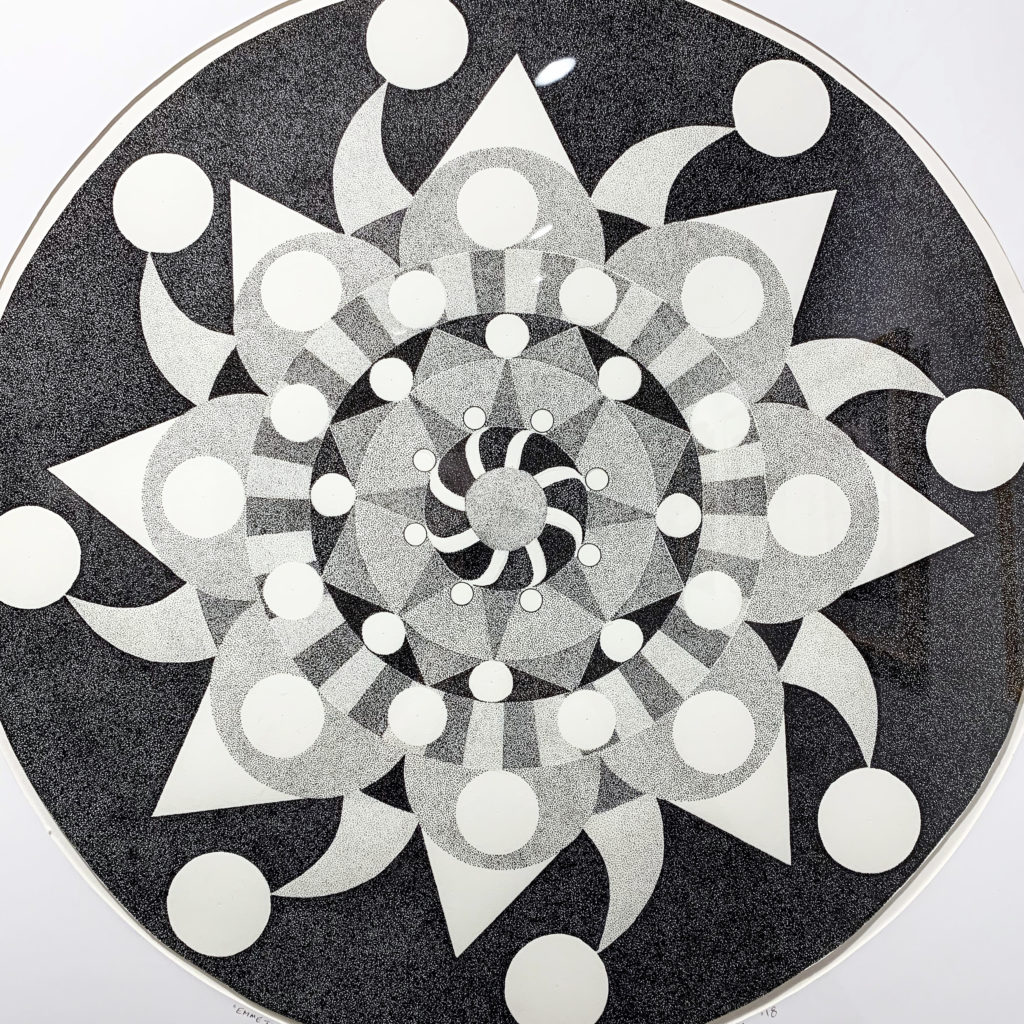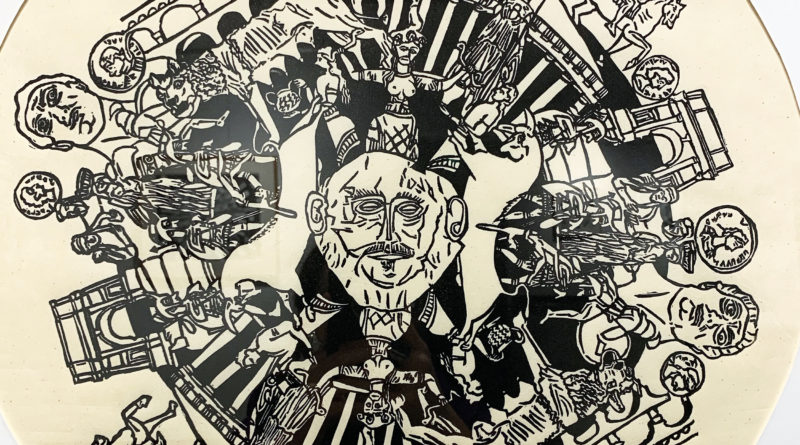Professor Emeritus Mark Hall brings his art back to Maryville College
Throughout November, a series of drawings and prints created by Mark Hall, Maryville College Professor Emeritus of Art, will be on display in the Clayton Center for the Arts’ Blackberry Farm and William “Ed” Harmon Galleries. With 14 drawings and seven linocut prints, each and every piece takes on the mandala form.
Before retiring from his full-time position in 2016, Hall taught various art classes for 15 years and held an administrative position for 10 of those years in the Fine Art department. Although he has intermittently returned since 2016 to teach art history survey courses, Hall finally decided to truly stop teaching and dedicate time to his art and other endeavors earlier this year.

In 1930, Mark Hall’s father actually had a pilot’s license and flew biplanes. This drawing, “Curtis-Wright Two,” is influenced by the notoriously faulty engine and spark plug set up that Curtis Wright planes (the type his father flew) had. Photo by Lauren McCarter

Titled after it’s completion, this pen and ink drawing, “Emmett Kelly,” reminded Mark Hall of a court jester or a clown. Emmett Kelly was one of the most famous clowns in Ringling Bros. and Barnum & Bailey circus. Photo by Lauren McCarter
Since then, Hall built his own studio near his house complete with a printing press and drafting table, which he opened on Groundhog Day, Feb. 2, 2019. All of the prints in this November show have been made since his studio opening, and all of the drawings, which include stippling to varying intensities, have been created within the last two years.
“I do it [stippling] for a couple reasons,” Hall said. “One was I like the texture. If you take an ink pen and try to put in a nice even black background, you won’t get it. You’ll always see the strokes. With stippling, you can get a nice even, velvety texture, which I just love. Then you can lighten and darken it as you choose.” Stippling is also easier to control than trying to draw consistently smooth lines.
“Everything in here is hand drawn, literally. If you look carefully, you’ll see some imperfections even in the circles,” Hall said. With the mandala form present in every piece, Hall plays with its versatility, which he intended to do from the start of planning this show.
“Carl [Gombert] and I have that, mandalas, in common,” Hall said. “It’s very odd … We do very different work, but we’ve had very similar influences in some ways. The mandala is something I have done forever—long before I came here. So, I decided just to play with it. I wanted to do a whole series.”
Hall grew up in Indianapolis, a city that was originally designed to be one-mile square with a circle in the middle. Having been around this circle many times, Hall feels it influenced him along with watching black and white TV as a child. Almost every drawing and print in the collection is devoid of color.
“I was raised in front of a black and white TV stand … The sign on and sign off always began with a test pattern, which wasn’t in color,” Hall said. “It was black and white, and it was a circular form—so I think I was influenced. I dream in black and white … I feel comfortable doing black and white. I see texture, value, and form in black and white very easily.”
There is one piece, “Chaos Theory,” that includes the slightest wash of purple amidst the black ink on white paper.
“It’s actually a very funny thing,” Hall said. “I was drinking lemonade, and the glass had some moisture on it. The acidic nature of the lemon juice hit a corner of that drawing, and it went lilac. So, then I did it on purpose, but the initial was an accident.”
To title his works, Hall often waited till he was finished creating. Through the process, he would see familiar imagery take form in the mingling shapes, creating titles like “Fungus in a Petri Dish” and “The Venus Flytrap.” There’s one called “The Radio Telescope” that reminded him of just that—a large antenna dish like one might see out in a field.
A professor of art history for 30 years, Hall created five different prints that each represent iconic works from consecutive time periods found in the textbook Hall used, “Art Through the Ages” by Helen Gardner.
“I thought well, you know, why not do a whole series of prints on some of the images that I have had to teach over and over and over again,” Hall said. Two final pieces Hall created for this show include imagery related to Donald Trump along with direct quotes.

“St. Don” is a hand colored lino cut print (one of 10) that includes imagery of Donald Trump. With Trump in the middle, he is surrounded by limousines, showgirls, and other symbols representing things he’s done or said. Photo by Lauren McCarter
“I thought why not use the mandala form, then his own words,” Hall said. “Those are direct quotes from him … his reference to his gold toilets, his love of money, and his love of showgirls. There will be people around here who look at those and are just disgusted. I understand that, but they need to understand there is nothing in those that isn’t an actual reference to what he’s said or done.”
There will be a reception for Hall’s mandalas on Nov. 15 in the galleries from 6 p.m. till 8 p.m. The galleries are also open Monday through Friday from 10 a.m. till 5 p.m.

